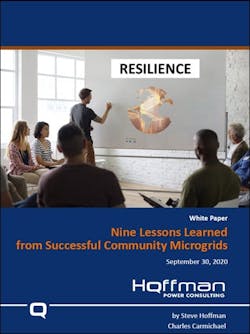Community Microgrid Lessons to Set a Project up for Success
When most people think about microgrids, they likely think about a resiliency tool or “back-up plan” for a critical facility, such as a hospital or school. But the community microgrid is a different animal all together. That’s according to a new report from Hoffman Power Consulting.
Get the full report.
Community microgrids can serve more than 1,000 energy users, the report points out, honing in on one of the biggest benefits of the community microgrid. Interestingly, while the benefits may seem obvious, according to Hoffman, very few community microgrids are operating or planned worldwide.
“Despite their limited number, existing community microgrid installations provide a wealth of leading practices,” the report states. “Awareness of successful projects, and lessons learned from them, can help microgrid developers and service providers make informed decisions when considering or embarking on community microgrid projects.”
This white paper documents a comprehensive review of community microgrids, which identified these practices.
The report starts off by exploring how those interested in community microgrids can define threats to resilience in a geographical area and ways the proposed community microgrid can effectively help mitigate the threats.
It also looks at how communities can bring energy efficiency to buildings in the proposed microgrid, as well as integrate distributed renewable generation and electric energy storage.
Then the report asks the reader to consider using the the energy-as-a-service (EaaS) business model to minimize or eliminate the need for the community or energy users to provide upfront capital for the project.
Opportunities may also exist to incorporate community education and learning activities into the project, according to the report.
Hoffman Power Consulting explains that lessons learned, which are documented in the white paper, can help microgrid developers and service providers work closely with communities, utilities, regulatory agencies, and other stakeholders to accelerate growth of the community microgrid market.
“Consider using the energy-as-a-service (EaaS) business model to minimize or eliminate the need for the community or energy users to provide upfront capital for the project.” — Hoffman Power Consulting
The report explores the following in detail:
- The relevant threats to resiliency
- Enhancing and integrating energy efficiency of buildings
- Integrating distributed renewable generation and storage
- The energy-as-a-service model
- Incorporating community education and learning
- Creating an “oasis microgrid”
- Providing benefits to traditional underserved populations
Download the full report, “Nine Lessons Learned from Successful Community Microgrids,” to explore the wealth of leading practices from a group of successful community microgrid installations.
